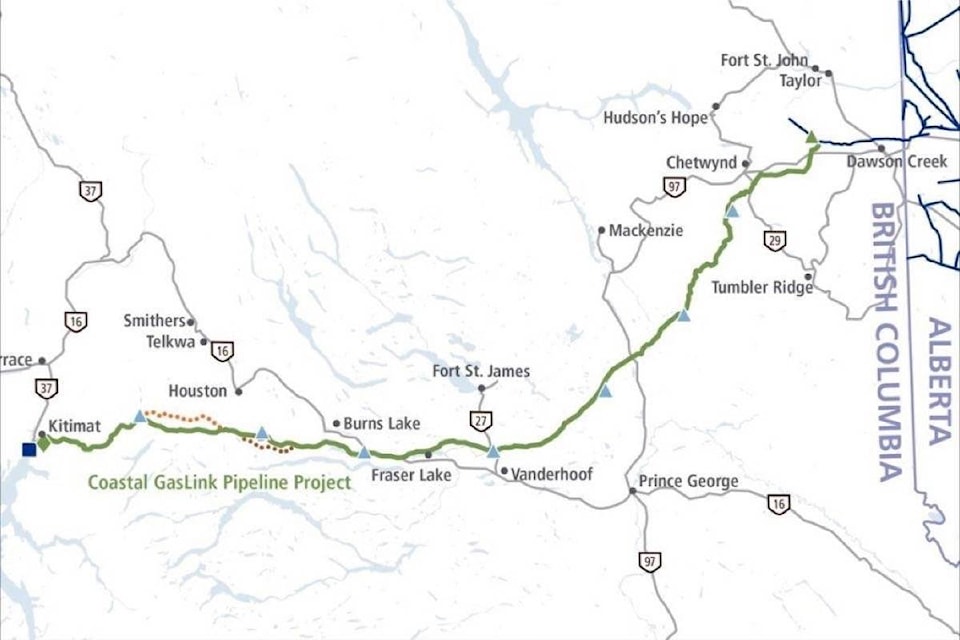While many eyes and much of the attention has been focused on the construction of LNG Canada’s multi-billion dollar plant in Kitimat, just how the natural gas will get to the facility is a mega-project in its own right.
Originally forecast at $4.8 billion when planning first started in 2011, TransCanada’s 670-kilometre Coastal GasLink pipeline from the northeastern B.C. gas fields to Kitimat is now estimated to cost $6.2 billion, making it arguably the second largest private sector expenditure in the province’s history.
“The new $6.2 billion costs are due to inflation from 2011 to 2018 dollars, scope changes and refinement [of capital expenditures],” said TransCanada official Terry Cunha. “It includes the $470 million in pre-construction work.”
Construction of the 48-inch diameter pipeline is expected to start next year at multiple locations along the pipeline route.
READ MORE: Pipeline company calls challenger “vexatious”
“These segments will be constructed in an order that will accommodate for terrain, season and resource considerations,” said Cunha.
A number of construction camps of various sizes will be set up along the route, with a workforce needed of approximately 2,500 people in a mix of people from elsewhere and those who live in the area of the pipeline’s route.
Civeo, which specializes in work camp accommodation, has a contract to supply four camps and has signed partnership agreements with four First Nations, one for each camp.
As with the LNG Canada plant, TransCanada’s Coastal GasLink subsidiary is emphasizing local employment and, in particular, indigenous employment.
Earlier this year Coastal GasLink announced it had signed $620 million in contracts with indigenous businesses and contractors that would come into play should LNG Canada give the green light to its plant.
“The $620 million that is being awarded locally for construction activities includes the costs of camp construction and operation,” said Cunha.
There will be an “additional $400 million anticipated to both B.C. northern communities and Indigenous communities during the construction period. This will total approximately $1 billion of local spend in B.C.,” he added.
READ MORE: All 20 First Nations sign Coastal GasLink pipeline agreement
As this is a separate project from LNG Canada’s plant, TransCanada is financing the construction on its own with a payback coming from 25-year agreements signed by the companies who own the gas that will be flowing through the pipeline. hose companies are the owners of LNG Canada — Shell, Petronas, PetroChina, Mitsubishi and Kogas Canada.
TransCanada has lined up four major construction companies for the pipeline work — Surerus Murphy Joint Venture (one of the joint venture partners is a company from Fort St. John), SA Energy Group, Macro Spiecapag Joint Venture and Pacific Atlantic Pipeline Construction Inc.
Pipeline construction is to be divided into what are called “spreads”. The Macro Spiecapag Joint Venture is to build 177 kilometres of the pipeline with a company release estimating its contract value alone to be more than $900 million.
Completion and in-service for Coastal GasLink is pegged at the latter part of 2021.
As part of its indigenous efforts, Coastal GasLink has signed economics benefits agreements with 20 First Nations who have traditional territory along the pipeline route. The Haisla First Nation at Kitamaat was the last one to sign.
While Coastal GasLink has emphasized that the agreement are with elected First Nations governments, a clan of the Wet’suwet’en First Nation called the Unist’ot’en or Dark House remain opposed to the project and first set up a camp blocking a portion of the pipeline route south of Houston in 2014. In the early days of the encampment, the Unist’ot’en relied on the help of indigenous rights advocates from elsewhere in maintaining the camp, conducting a public relations campaign opposing the pipeline and warning they were about to be arrested by the RCMP.
A Coastal GasLink pipeline official said on Tuesday that the pipeline route is still being finalized.
The pipeline is also being challenged by Smithers resident Michael Sawyer who wants the project, which has environmental clearance from the provincial government, to be reviewed by the federal National Energy Board.
